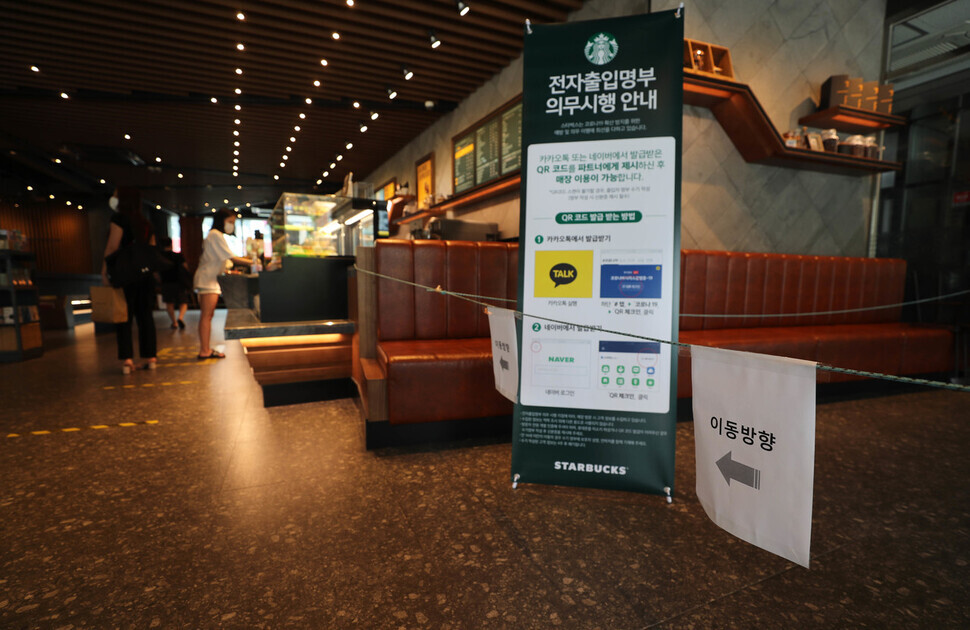hankyoreh
Links to other country sites 다른 나라 사이트 링크
Seoul enters week of heightened social distancing to curb resurgence of COVID-19 cases

The Seoul Metropolitan Government designated the period from Aug. 30 to Sept. 6 as a weeklong “10 million-person standstill” with the central government’s implementation of “quasi-Level 3 social distancing measures.” On the first day after it took effect, citizens of Seoul and other communities in the Seoul Capital Area (SCA) seemed to be calmly adjusting to the more stringent guidelines.
In an online briefing on Aug. 30 after the surprise implementation of “quasi-Level 3 social distancing” (Level 2.5) for the SCA, acting Seoul Mayor Seo Jung-hyup said, “From today until Sept. 6, we will be having a week of standstill for 10 million people.”
Seo went on to plead with the public to “resolutely commit to giving up daily activities and thoroughly observe everyday quarantine measures for the next week.”
“In particular, we will focus on restricting access to closely packed, densely crowded, and unventilated environments to young people, with people in their 20s to 40s accounting for 38.5% of all confirmed COVID-19 cases over the past week,” he added.
A key element of the “quasi-Level 3” distancing measures is the restriction of crowd facilities to minimize contact among people. At franchise coffee shops in the SCA, customers cannot consume food or beverages on the premises and are only allowed to place orders for takeout and delivery. Coffee franchises like Starbucks and Coffee Bean have been the settings for numerous infections as predominantly young people have continued to flock there even after the virus’s resurgence. Dozens of patrons at a Starbucks by Yadang Station in Paju, Gyeonggi Province, tested positive after being seated on the same floor as another customer earlier this month. The original patient spent two and a half hours at the cafe before being diagnosed. Another infection cluster occurred at a Hollys Coffee branch in Seoul’s Gangnam neighborhood.
A large sign reading “Takeout Only” was posted at the entrance of a Starbucks near the Seoul National University station in Seoul’s Gwanak District on the morning of Aug. 30. Ordinarily, it’s the most popular café in the area. But on that day, it was nearly devoid of customers, with all of the tables and chairs moved off to one side. As customers entered, an employee waiting by the entrance took their temperature and scanned QR codes to keep a digital visitor log. Other employees repeatedly asked patrons to “please maintain at least two meters’ distance” from others as they waited in line to order.
Restaurants in the SCA are allowed to operate normally during daytime hours, but can only accept takeout and delivery orders between the hours of 9 pm and 5 am. Perhaps out of concerns over COVID-19’s spread, many restaurant frequenters could be seen placing takeout orders during the daytime as well. One knife-cut noodle restaurant in Seoul’s Dongjak District was operating its own “drive-thru” service that afternoon, with customers placing orders by telephone and transferring the funds digitally before driving to the restaurant, where an employee handed over their orders.
“We’ve been taking orders this way because of the customers who have been reluctant to visit restaurants since the virus [outbreak],” a restaurant employee explained.
By Lee Jae-ho and Song Gyung-hwa, staff reporters
Please direct comments or questions to [english@hani.co.kr]

Editorial・opinion
![[Column] Tariffs on China: Trump was dumb, Biden dumber [Column] Tariffs on China: Trump was dumb, Biden dumber](https://flexible.img.hani.co.kr/flexible/normal/500/300/imgdb/original/2024/0520/191716191153918.jpg) [Column] Tariffs on China: Trump was dumb, Biden dumber
[Column] Tariffs on China: Trump was dumb, Biden dumber![[Column] What if Seoul took reunification by force off the table? [Column] What if Seoul took reunification by force off the table?](https://flexible.img.hani.co.kr/flexible/normal/500/300/imgdb/original/2024/0520/3017161928630494.jpg) [Column] What if Seoul took reunification by force off the table?
[Column] What if Seoul took reunification by force off the table?- [Editorial] Intensifying US-China rivalry means Seoul must address uncertainty with Beijing sooner than later
- [Column] When ‘fairness’ means hate and violence
- [Editorial] Yoon must stop abusing authority to shield himself from investigation
- [Column] US troop withdrawal from Korea could be the Acheson Line all over
- [Column] How to win back readers who’ve turned to YouTube for news
- [Column] Welcome to the president’s pity party
- [Editorial] Korea must respond firmly to Japan’s attempt to usurp Line
- [Editorial] Transfers of prosecutors investigating Korea’s first lady send chilling message
Most viewed articles
- 1Xi, Putin ‘oppose acts of military intimidation’ against N. Korea by US in joint statement
- 2Kim Jong-un wanted to meet with residents of shelled Yeonpyeong Island in South, Moon recalls in mem
- 3To weigh costs and benefits, Korea must stop treating US troop presence as a sacred cow
- 4[Column] What if Seoul took reunification by force off the table?
- 5Berlin mayor hints at tearing down ‘comfort women’ memorial in city
- 6[Column] Tariffs on China: Trump was dumb, Biden dumber
- 7[Editorial] Transfers of prosecutors investigating Korea’s first lady send chilling message
- 8[Exclusive] Truth commission to seek additional murder charges for figures behind 1980 Gwangju massa
- 9KEPCO undergoes repairs for cracks in nuclear reactor containment buildings in UAE
- 10‘Shot, stabbed, piled on a truck’: Mystery of missing dead at Gwangju Prison